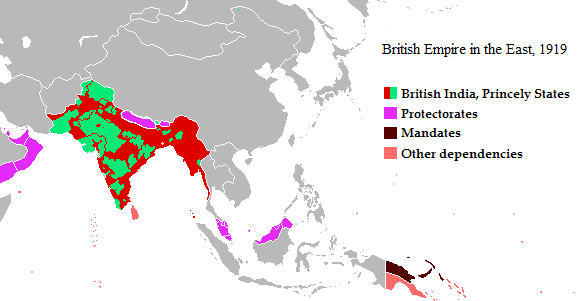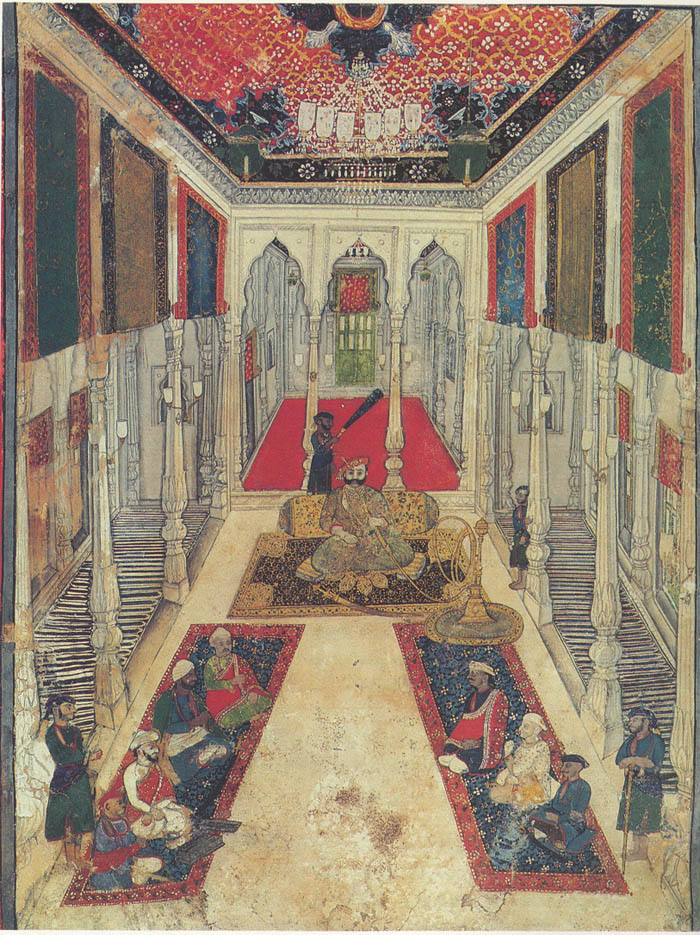|
Akkalkot State
Akkalkot State during the British Raj, was a Maratha princely state ruled by the Bhonsle dynasty. The non-salute state came under the Deccan States Agency and was bordered by Hyderabad State and the Bombay Presidency. The area of the state was ; its population in 1901 was 82,047, while the population of Akkalkot town itself was 8,348 in that year. In 1911, the state enjoyed a revenue estimated at Rs.26,586/- and paid a tribute to the British Raj of Rs.1,000/-. History The ruling dynasty were descendants of Fattesing Bhosle, who was adopted by Chhattrapati Shahu, grandson of Chhattrapati Shivaji, around the year 1708. Upon his adoption, Ranoji assumed the name 'Fatehsinh Bhonsle' and received in appenage the town of Akkalkot and surrounding areas. These estates remained a fief within the state of Satara until 1848, when the rulers of Satara (Chhatrapati Shahu's designated successors) were deposed by the British. Akkalkot then became one of several vassals of Satara to ... [...More Info...] [...Related Items...] OR: [Wikipedia] [Google] [Baidu] |
British India
The provinces of India, earlier presidencies of British India and still earlier, presidency towns, were the administrative divisions of British governance in South Asia. Collectively, they have been called British India. In one form or another, they existed between 1612 and 1947, conventionally divided into three historical periods: *Between 1612 and 1757, the East India Company set up "factories" (trading posts) in several locations, mostly in coastal India, with the consent of the Mughal emperors, Maratha Empire or local rulers. Its rivals were the merchant trading companies of Portugal, Denmark, the Netherlands, and France. By the mid-18th century three ''Presidency towns'': Madras, Bombay and Calcutta, had grown in size. *During the period of Company rule in India, 1757–1858, the Company gradually acquired sovereignty over large parts of India, now called "Presidencies". However, it also increasingly came under British government oversight, in effect sharing sovereig ... [...More Info...] [...Related Items...] OR: [Wikipedia] [Google] [Baidu] |
Chattrapati Shahu
Shahu I (Shivaji Sambhaji Raje Bhonsale; ; 18 May 1682 – 15 December 1749) was the fifth Chhatrapati or head of state of the Maratha Empire founded by his grandfather, Shivaji I. He was born into the Bhonsle family and was the son of Sambhaji I and Yesubai. At a young age, he was taken into custody at the Siege of Raigad by Mughal emperor Aurangzeb, and held captive. He was released from captivity after the death of Aurangzeb in the hope of engineering an internecine struggle among the Maratha factions of Tarabai and Shahu. Shahu emerged victorious in the bloody Battle of Khed and was crowned as Chhatrapati. During Shahu's reign, Maratha power and influence extended to much of central and western India, which had then created a strong Maratha Kingdom. After his death, his ministers and generals such as the Peshwa Bhats and their lieutenants of the Shinde and Holkar house, Senasahibsubha Bhonsles of Nagpur, and Senakhaskhel Gaikwad of Baroda administered their s ... [...More Info...] [...Related Items...] OR: [Wikipedia] [Google] [Baidu] |
Princely States Of Maharashtra
A prince is a male ruler (ranked below a king, grand prince, and grand duke) or a male member of a monarch's or former monarch's family. ''Prince'' is also a title of nobility (often highest), often hereditary, in some European states. The female equivalent is a princess. The English word derives, via the French word ''prince'', from the Latin noun , from (first) and (head), meaning "the first, foremost, the chief, most distinguished, noble ruler, prince". In a related sense, now not commonly used, all more or less sovereign rulers over a state, including kings, were "princes" in the language of international politics. They normally had another title, for example king or duke. Many of these were Princes of the Holy Roman Empire. Historical background The Latin word (older Latin *prīsmo-kaps, ), became the usual title of the informal leader of the Roman senate some centuries before the transition to empire, the ''princeps senatus''. Emperor Augustus established the forma ... [...More Info...] [...Related Items...] OR: [Wikipedia] [Google] [Baidu] |
List Of Indian Princely States
Before the partition of India in 1947, about 584 princely states, also called "native states", existed in India. These were not part of British India, the parts of the Indian subcontinent which were under direct British administration, but rather under indirect rule, subject to subsidiary alliances. Things moved quickly after the partition of British India in 1947. By the end of 1949, all of the states had chosen to Instrument of Accession, accede to one of the newly independent states of India or Pakistan or else had been conquered and annexed. Overview In principle, the princely states had internal autonomy, while by treaty the British Crown had suzerainty and was responsible for the states' external affairs. In practice, while the states were indeed ruled by potentates with a variety of titles, the British still had considerable influence. By the time of the departure of the British in 1947, only four of the largest of the states still had their own British Resident ... [...More Info...] [...Related Items...] OR: [Wikipedia] [Google] [Baidu] |
List Of Maratha Dynasties And States
This is a list of Maratha dynasties and Maratha princely states in the Indian subcontinent. Maratha States The Maratha Salute state and Head of State by precedence * Baroda, title Maharaja Gaikwad, Hereditary salute of 21-guns * Gwalior, title Maharaja Shinde, Hereditary salute of 21-guns * Indore (Holkar State), title Maharaja Holkar, Hereditary salutes of 19-guns * Kolhapur State, title Maharaja Bhonsle Chhatrapati, Hereditary salutes of 19-guns * Dewas State (1728–1948) of Pawar clan. ** Dewas State Senior, title Maharaja, Hereditary salute of 15-guns ** Dewas State Junior, title Maharaja, Hereditary salute of 15-guns * Sangli, title Raja, Hereditary salute of 11-guns * Bhor (Gandekar State), title Raja, Hereditary salute of 9-guns * Jawhar State, title Maharaja, Hereditary salute of 9-guns * Sawantwadi State, title Raja, Hereditary salute of 9-guns * Mudhol State, title Raja, Hereditary salute of 9-guns Non-salute states Non-salute Maratha states, alphabetically ... [...More Info...] [...Related Items...] OR: [Wikipedia] [Google] [Baidu] |
Maratha Empire
The Maratha Empire, also referred to as the Maratha Confederacy, was an early modern India, early modern polity in the Indian subcontinent. It comprised the realms of the Peshwa and four major independent List of Maratha dynasties and states, Maratha states under the nominal leadership of the former. The Marathas were a Marathi language, Marathi-speaking peasantry group from the western Deccan Plateau (present-day Maharashtra) that rose to prominence under leadership of Shivaji (17th century), who revolted against the Bijapur Sultanate and the Mughal Empire for establishing "Hindavi Swarajya" (). The religious attitude of Aurangzeb, Emperor Aurangzeb estranged Kafir, non-Muslims, and the Deccan wars, Maratha insurgency came at a great cost for his men and treasury. The Maratha government also included warriors, administrators, and other nobles from other Marathi people, Marathi groups. Shivaji's monarchy, referred to as the Maratha Kingdom, expanded into a large realm in the 18th ... [...More Info...] [...Related Items...] OR: [Wikipedia] [Google] [Baidu] |
Baroda
Vadodara (), also known as Baroda, is a city situated on the banks of the Vishwamitri River in the Indian state of Gujarat. It serves as the administrative headquarters of the Vadodara district. The city is named for its abundance of banyan (''vad'') trees. Vadodara is also locally referred to as the ''Sanskrutik Nagari'' () and ''Kala Nagari'' () of India. The city is prominent for landmarks such as the Laxmi Vilas Palace, which served as the residence of the Maratha royal Gaekwad dynasty that ruled over Baroda State. It is also the home of the Maharaja Sayajirao University of Baroda. Etymology The city was once called Chandanavati after Raja Chandan of the Dod Parmar Rajputs. The capital was also known as Virakshetra (Land of Warriors). Later, it was known as Vadpatraka or Vadodará, and according to tradition, is a corrupt form of the Sanskrit word ''vatodara'', meaning "in the belly of the banyan tree". It is, as of 2009, almost impossible to ascertain when the var ... [...More Info...] [...Related Items...] OR: [Wikipedia] [Google] [Baidu] |
Dominion Of India
The Dominion of India, officially the Union of India, * * was an independent dominion in the British Commonwealth of Nations existing between 15 August 1947 and 26 January 1950. Until its Indian independence movement, independence, India had been ruled as an informal empire by the United Kingdom. The empire, also called the British Raj and sometimes the British Indian Empire, consisted of regions, collectively called British India, that were directly administered by the British government, and regions, called the princely states, that were ruled by Indian rulers under a system of paramountcy, in favor of the British. The Dominion of India was formalised by the passage of the Indian Independence Act 1947, which also formalised an independent Dominion of Pakistan—comprising the regions of British India that are today Pakistan and Bangladesh. The Dominion of India remained "India" in common parlance but was geographically reduced by the lands that went to Pakistan, as a separate d ... [...More Info...] [...Related Items...] OR: [Wikipedia] [Google] [Baidu] |
Chhattrapati Shivaji
Chhatrapati is a royal title from Sanskrit used to denote a king. The word "Chhatrapati" is a Sanskrit language compound word of '' chhatra'' (''parasol'' or ''umbrella'') and '' pati'' (''master/lord/ruler''). This title was used by the House of Bhonsle, between 1674 and 1818, as the heads of state of the Maratha Empire and later by the states of Satara and Kolhapur. List of Chhatrapatis of the Maratha Empire *Shivaji I *Sambhaji *Rajaram I *Shivaji II *Shahu I * Rajaram II *Shahu II * Pratap Singh of Satara See also * List of Maratha rulers * House of Bhonsle * Maratha Empire * Maratha * Maratha titles The following list includes a brief about the titles of nobility or orders of chivalry used by the Marathas of India and by the Marathis/ Konkanis in general. Titles used by the Maratha Royals The titles used by royalty, aristocracy and nobil ... Notes References * V. S. Kadam, 1993. ''Maratha Confederacy: A Study in Its Origin and Development''. Munshiram Mano ... [...More Info...] [...Related Items...] OR: [Wikipedia] [Google] [Baidu] |
Shivaji
Shivaji I (Shivaji Shahaji Bhonsale, ; 19 February 1630 – 3 April 1680) was an Indian ruler and a member of the Bhonsle dynasty. Shivaji carved out his own independent kingdom from the Sultanate of Bijapur that formed the genesis of the Maratha Empire. In 1674, he was formally crowned the ''Chhatrapati'' of his realm at Raigad Fort. Shivaji offered passage and his service to the Mughal emperor Aurangzeb to invade the declining Sultanate of Bijapur. After Aurangzeb's departure for the north due to a war of succession, Shivaji conquered territories ceded by Bijapur in the name of the Mughals. Following his defeat at the hands of Jai Singh I, the senior most general ("Mirza (noble), Mirza Raja") of the Mughal Empire, in the Battle of Purandar, Shivaji entered into vassalage with the Mughal empire, assuming the role of a Mughal chief and was conferred with the title of ''Raja (title), Raja'' by Aurangzeb. He undertook military expeditions on behalf of the Mughal Empire for a ... [...More Info...] [...Related Items...] OR: [Wikipedia] [Google] [Baidu] |








